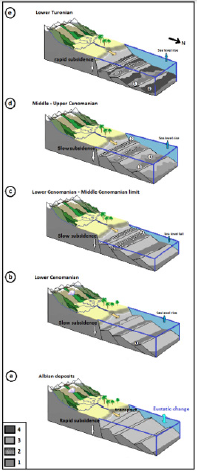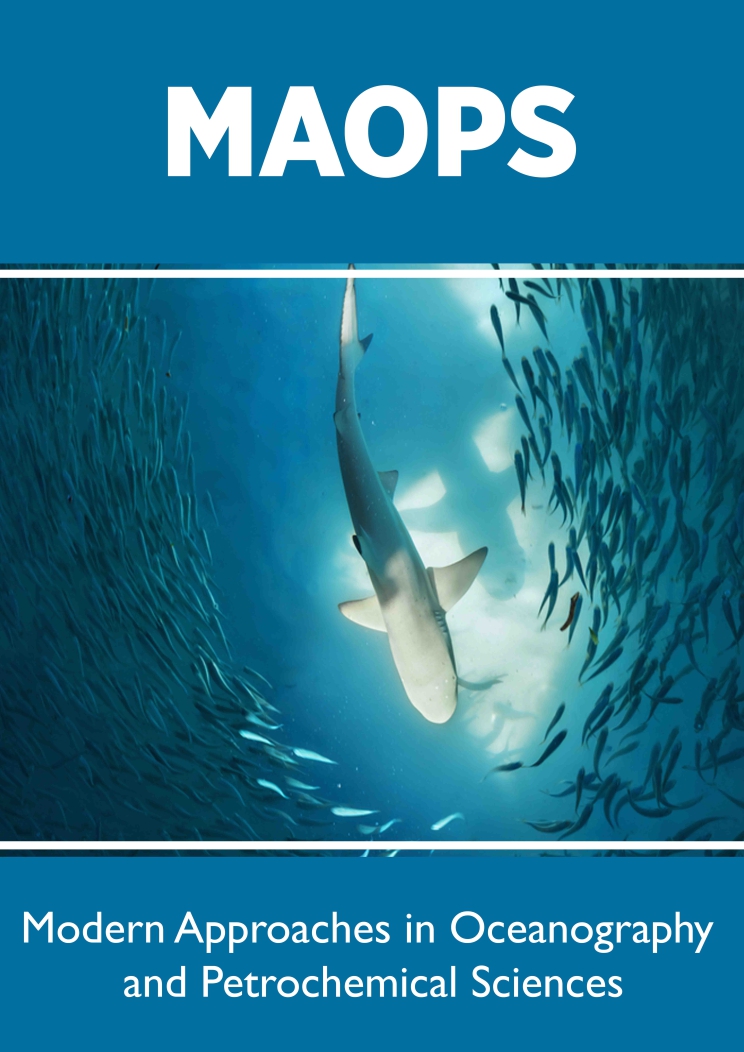
Lupine Publishers Group
Lupine Publishers
Menu
ISSN: 2637-6652
Opinion(ISSN: 2637-6652) 
How was Like the Paleoenvironment During the Cenomanian Age in the Northeastern Algeria? Volume 3 - Issue 2
Bensekhria Aida1,2*, Marmi Ramdane3 and Yahiaoui Abdelouahab1
- 1State Key Laboratory of Natural Hazards and Regional Planning, University of Batna , Algeria
- 2University of Mentouri Brothers - Constantine , Department of Geological Sciences, Constantine, Algeria
- 3State Key Laboratory of Geology and Environment, University of Mentouri Brothers - Constantine 1, Algeria
Received:February 24, 2020 Published:March 11, 2020
Corresponding author: Baisakhi Aida, State Key Laboratory of Natural Hazards and Regional Planning, University of Batna , Algeria
DOI: 10.32474/MAOPS.2020.03.000160
Introduction
Decipher what the Earth’s ancient environment was like thousands, may be millions of years ago became one of the most objectives of paleontology and Archaeology. Nevertheless, the significant fluctuations of the microfauna contents and the dominance phases of alternation between benthic and planktonic foraminifera reveal changes as well in the depositional environment. The results of this study indicate that the supposed depositional environment is a calm and relatively deep environment which can be located around the middle to the external platform, where the depth of waters exceeds 200 m. These waters are characterized by a poor percentage in oxygen (Figure 1a).
Palaeoenvironments reconstruction
Lower cenomanian
The lower Cenomanian has a low percentage of planktonic foraminifera with a markedly low specific diversity. Radiolarians are rare, often even completely absent. Some common mineral elements, such as gypsum and pyrite; rare fossils like: ammonites but are often pyritic, not to mention the main dark color of marls and clayey marls facies. Poor oxygenation of the bottom waters has prevented normal development of benthic organisms. The rare present species are for many authors such as cited by [1] as oxygen deficiency tolerant forms. Finally, the frequent pyritization of tests and shells as well as the presence of pyrite is an additional indication of poor oxygenation [2], because this mineral requires an anoxic environment for its formation. It is also necessary to consider the presence of gypsum throughout the studied section and which is never in form of a layer, on the contrary mixed within the levels. This element could probably be regarded as a secondary element, resulting from the transformation of pyrite. During the Cenomanian, the depth of deposits seems to be lower and corresponds to calm and relatively deep environment, which can be located around the middle to the external platform (Figure 1b).
Lower to middle cenomanian
Compared to the previous period, the middle - upper Cenomanian is therefore marked by a dominance of planktonic foraminifera (mainly globular), a more developed benthic microfauna but the specific diversity is still relatively low. The most common species include, in particular, some agglutinated, often dominant (Textularia sp., Thomasinella punica) and small calcareous forms (Gavelinella). Overall, the levels concerned are characterized by a renewal and a greater diversification of benthic microfauna. Oysters levels are sometimes numerous and rich in ostreids. The presented micro-faunistic associations always indicate a deep and calm environment, of external platform type, although a change in the environment is noticeable. Indeed, greater occurrence and diversity of benthic organisms suggest either a slight decrease in depositional depth or an improvement in bottom oxygenation conditions. Both hypotheses are also likely; in addition, a total absence of pyrite is noticed. Furthermore, near the upper part of lower Cenomanian, within Fahdene Formation and at the end of Mantelliceras dixoni Zone, no ammonites were found at this level in one hand. On the other hand, the Formation of Fahdene at this zone is marked by a distinct break (the Trough) in sedimentation by a sudden regression of sea level shown by a thin bed of beige color limestone topped by an oyster and bioturbated surface (Figure 1c). It is succeeded by transgressive clayey brown marl with Cuinningtoniceras inerme ammonite which is equivalent of the Thatcher Limestone: orange-brown clay with carbonates concretions containing a C. tarrantense fauna found in Texas [3]. In the Anglo-Paris basin Robaszynski et al, 1999, they recognized: “The presence of an important fall in sea-level represented on the basin margins by a marked break at the lower-middle Cenomanian boundary” they place this trough within the Zone of Mantelliceras dixoni, which is quiet matched with our area.
Figure 1: Palaeoenvironment reconstructing model of
Nouader site.
a. Albian deposits model.
b. Lower Cenomanian high level marine prism with
marls and rare interval of limestone facies of the lower part
of Fahdene formation 1.
c. Lower Cenomanian to middle Cenomanian
boundary showing the break of sedimentation (Trough),
which is a regressive interval with limestone facies topped
by an oyster surface 2.
d. Middle to upper Cenomanian presenting a
transgressive interval with limestone and marl-limestone
facies of the upper part of Fahdene formation 3.

Upper cenomanian
The end of the Cenomanian of Nouader site carries the print of the C/T crisis. It is characterized by marly limestone facies known as black shales, the famous Bahloul levels described at many places (Tunisia, northeaster Algeria); these black color laminated appearance levels are rich in organic carbon. (TOC value is about 4.5%). Other characteristic of this level is the dominance of globular planktonic foraminifera (Hedbergella sp., Heterohelix sp., Heterohelix globulosa, Globigerinelloides sp., Whiteinella sp., Whiteinella baltica, Whiteinella brotonensis, W. praehelvetica, and W. archaeocretacea). The presented benthic species are globally very little diversified, such as Nodosaridae, Textularia and Lenticulina rotulata, whereas the oyster’s levels are absent. Some dispersion of filaments with the presence of glauconite was well noticed especially in sample 117. In addition, the phenomenon of ferruginization is very important. Tolerant forms of minimum oxygen (such as: Heterohelix) indicate relative anoxia corresponding to a minimum oxygen zone (the beginning of the transgressive interval from here) developed during the Late Cenomanian to lower Turonian according to the work of [4&5]. All these characteristics provide information about the circalittoral area (external platform-type) environment (Figure 1d).
Lower turonian
This interval is marked by an abundance of the genera Whiteinella and Heterohelix, especially the species Whiteinella baltica and Heterohelix globulosa .Also, the microfaunistic associations composed of the species Whiteinella archaeocretacea, W. baltica, W. brittonensis, Heterohelix moremani, H. globulosa, Hedbergella simplex, H. delrioensis, and H. planispira, allow to attribute a Turonian age to this interval. The appearance of the elongated test forms (endofauna) represented by Nodosaria, reflects a decrease of the oxygen level and which would explain this decrease of the planktonic population [6,7]. In addition, the appearance of keeled forms (Dicarinella) reflects a relatively deep environment Hart & Bailey, 1980 [8]. All these data evoke an external platform-type repository environment (Figure 1e).
References
- Koutsoukos EAM, Leary PN and Hart MB (1990) Latest Cenomanian-earliest Turonian low-oxygen tolerant benthonic foraminifera: a case study from the Sergipe Basin (NE Brazil) and the western Anglo-Paris Basin (southern England). Palaeogeography, Palaeoclimatology, Palaeoecology 77(2): 145-77.
- Andreu Boussut B (1991) Les Ostracodes du Crétacé moyen (Barrémien à Turonien), le long d'une transversale Agadir-Nador (Maroc). Toulouse, France: Strata pp. 1-910.
- Hancock JM (2003) Lower sea levels in the Middle Cenomanian. Carnets de Géologie L02 p: 1-6.
- Keller G, Pardo A (2004) Age and palaeoenvironment of the Cenomanian-Turonian global stratotype section and point at Pueblo Colorado. Marine Micropaleontology 51(1-2): 95-128.
- Robaszynski F, Caron M, Amédro F, Dupuis C, Hardenbol J, et al. (1993) Le Cénomanien de la région de Kalaat Senan (Tunisie Centrale). Bulletin des Centres de Recherche Exploration-Production Elf-Aquitaine 17: 395-433.
- Robaszynski F, Caron M, Amedro F, Dupuis C, Hardenbol J, et al. (1994) Le Cénomanien de la région de Kalaat Senan (Tunisie Centrale). Revue de Paléobiologie 12(2): 351-505.
- Hart MB (1980) The recognition of mid Cretaceous sea-level changes by means of foraminifera. Cretaceous Research 1(4): 289-297.
- Robaszynski F, Faouzi ZagrarniM, Caron M, Amedro F (2010) The global bio-events at the Cenomanian-Turonian transition in the reduced Bahloul Formation of Bou Ghanem (Central Tunisia). Cretaceous Research 31(1): 1-15.

Top Editors
-

Mark E Smith
Bio chemistry
University of Texas Medical Branch, USA -

Lawrence A Presley
Department of Criminal Justice
Liberty University, USA -

Thomas W Miller
Department of Psychiatry
University of Kentucky, USA -

Gjumrakch Aliev
Department of Medicine
Gally International Biomedical Research & Consulting LLC, USA -

Christopher Bryant
Department of Urbanisation and Agricultural
Montreal university, USA -

Robert William Frare
Oral & Maxillofacial Pathology
New York University, USA -

Rudolph Modesto Navari
Gastroenterology and Hepatology
University of Alabama, UK -

Andrew Hague
Department of Medicine
Universities of Bradford, UK -

George Gregory Buttigieg
Maltese College of Obstetrics and Gynaecology, Europe -

Chen-Hsiung Yeh
Oncology
Circulogene Theranostics, England -
.png)
Emilio Bucio-Carrillo
Radiation Chemistry
National University of Mexico, USA -
.jpg)
Casey J Grenier
Analytical Chemistry
Wentworth Institute of Technology, USA -
Hany Atalah
Minimally Invasive Surgery
Mercer University school of Medicine, USA -

Abu-Hussein Muhamad
Pediatric Dentistry
University of Athens , Greece

The annual scholar awards from Lupine Publishers honor a selected number Read More...




